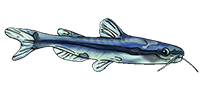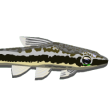| Scientific Name | Ancistrus ranunculus Muller, Rapp Py-Daniel & Zuanon, 1994 |
| Common Names | L034, Medusa Pleco Bredhovedet Antenne-sugemalle (Denmark), Kaulquappenwels/Bristle Bushmouth (Germany) |
| Type Locality | Rio Xingú, furo do Tucum Seco, near Arroz Cru, Pará State, Brazil. |
| Pronunciation | an SISS truss - rah nun kew luss |
| Etymology | The name Ancistrus is derived from the Greek word agkistron, meaning hook, in reference to the interopercular odontodes that are hooked. This specific epithet literally means small frog or tadpole (ranunculus=diminutive frog or tadpole) and refers to its unusually wide head. |
| Articles | |
| Size | 129mm or 5.1" SL. Find near, nearer or same sized spp. |
| Identification | Mature males and sometimes females have soft tentacles (bushy fleshy growths) on the snout - this is unique to the genus Ancistrus. Although all black, this is an easily identified species of Ancistrus due to its extreme head-width. |
| Sexing | Both sexes exhibit the Ancistrus trademark head-tentacles but they are much more prominent in sexually mature males. |
| Distribution | South America: Xingu and Tocantins River basins in Brazil. Amazon, Lower Amazon, Tocantins (click on these areas to find other species found there) Amazon, Lower Amazon, Xingu (click on these areas to find other species found there) Login to view the map. |
| IUCN Red List Category | Near Threatened , range map and more is available on the IUCN species page. Last assessed 2018. |
| Temperature | 25.0-28.0°C or 77-82.4°F (Show species within this range) |
| Feeding | Although still omnivorous, tends to be more of a carnivore than your average Ancistrus. User data. |
| Furniture | Natural habitat is stony streams. Prefers to hide between cracks in the rock-base or under flat stones on the bottom. |
| Compatibility | A good complement to most aquariums, they are not aggressive to other species. Males may fight over territory if kept in too small a tank. |
| Suggested Tankmates | All community fish, small to medium sized cichlids. |
| Breeding | Typical Ancistrus breeding behaviour. Males stay in caves and guard the brood. Females lay about 8 to 12 eggs. Eggs hatch after 5-7 days. After about 10 days the yolk sac is totally absorbed and the young start to eat. Fry are not problematic to raise. Once conditioned for spawning they spawn as often as common Ancistrus. Further information in breeding reports and Shane's World articles. |
| Breeding Reports | There are 2 breeding reports, read them all here. |
| Reference | Ichthyological Exploration of Freshwaters v. 5 (no. 4), pp 290, Fig. 1. |
| Registered Keepers | There are 113 registered keepers, view all "my cats" data. |
| Wishlists | Love this species? Click the heart to add it to your wish list. There are 13 wishes to keep this species, see who wants what. |
| Spotters | Spotted this species somewhere? Click the binoculars! There are 44 records of this fish being seen, view them all. |
| Forum BBCode | |
| Search for A. ranunculus | |
| Look up A. ranunculus on AquaticRepublic.com | |
 | Look up A. ranunculus on Fishbase |
 | Look up A. ranunculus on Encyclopedia of Life |
 | Look up A. ranunculus on Global Biodiversity Information Facility |
| LFS label creator ARN ref:1.4.4.190 | |
| Last Update | 2025 Jan 01 12:06 (species record created: 2001 Apr 25 00:00) |





/siluriformes/loricariidae/ancistrus/ranunculus/1.jpg)
/siluriformes/loricariidae/ancistrus/ranunculus/2.jpg)
/siluriformes/loricariidae/ancistrus/ranunculus/3.jpg)
/siluriformes/loricariidae/ancistrus/ranunculus/4.jpg)
/siluriformes/loricariidae/ancistrus/ranunculus/5.jpg)
/siluriformes/loricariidae/ancistrus/ranunculus/6.jpg)
/siluriformes/loricariidae/ancistrus/ranunculus/7.jpg)
/siluriformes/loricariidae/ancistrus/ranunculus/8.jpg)
/siluriformes/loricariidae/ancistrus/ranunculus/9.jpg)
/siluriformes/loricariidae/ancistrus/ranunculus/10.jpg)
/siluriformes/loricariidae/ancistrus/ranunculus/11.jpg)
/siluriformes/loricariidae/ancistrus/ranunculus/12.jpg)
/siluriformes/loricariidae/ancistrus/ranunculus/13.jpg)
/siluriformes/loricariidae/ancistrus/ranunculus/14.jpg)
/siluriformes/loricariidae/ancistrus/ranunculus/15.jpg)
/siluriformes/loricariidae/ancistrus/ranunculus/16.jpg)
/siluriformes/loricariidae/ancistrus/ranunculus/17.jpg)
/siluriformes/loricariidae/ancistrus/ranunculus/18.jpg)
/siluriformes/loricariidae/ancistrus/ranunculus/19.jpg)
/siluriformes/loricariidae/ancistrus/ranunculus/20.jpg)
/siluriformes/loricariidae/ancistrus/ranunculus/21.jpg)
/siluriformes/loricariidae/ancistrus/ranunculus/22.jpg)
/siluriformes/loricariidae/ancistrus/ranunculus/23.jpg)